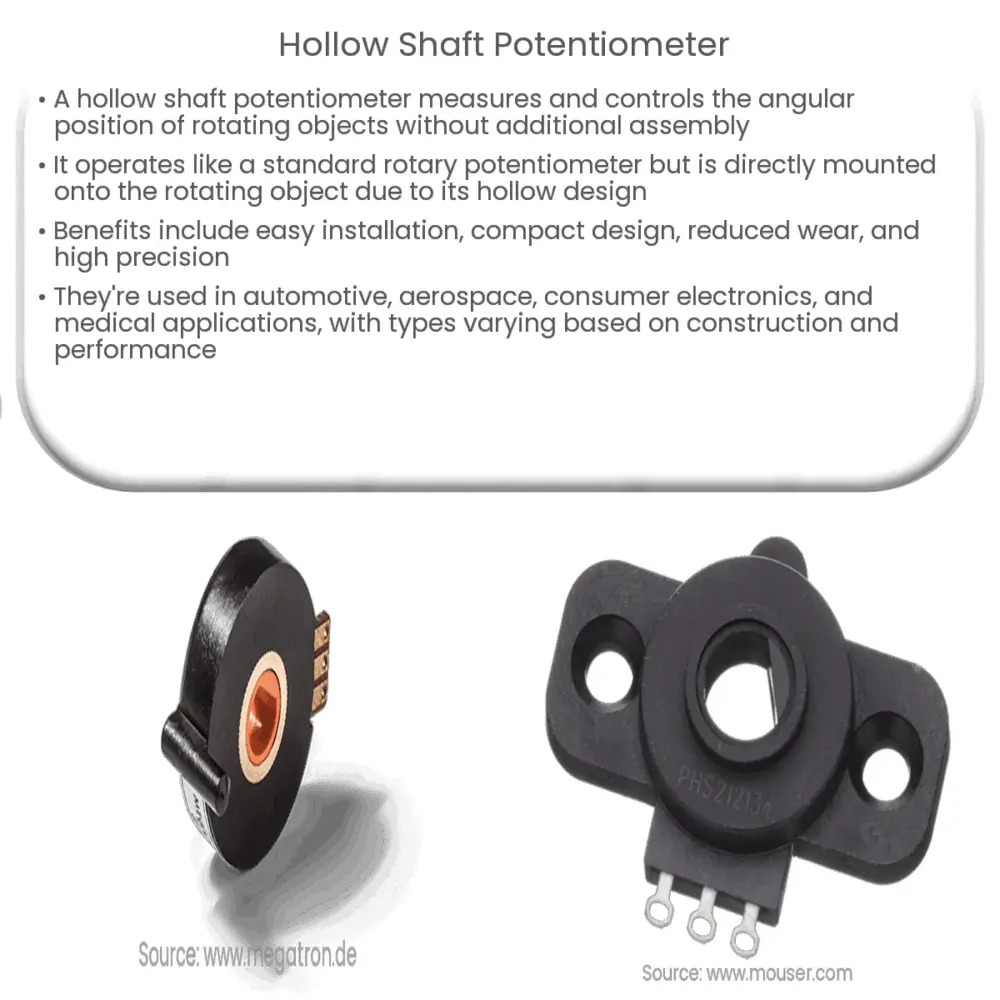A hollow shaft potentiometer is a compact variable resistor for precise angular position measurement and control in various applications.

Hollow Shaft Potentiometer: An Overview
Introduction
A hollow shaft potentiometer is a type of variable resistor that is designed to accurately measure and control the angular position of a rotating object, such as a motor shaft or a knob on a control panel. This potentiometer features a hollow cylindrical shaft, allowing it to be directly mounted onto the rotating object without the need for additional components or complex assembly processes. In this article, we will discuss the working principle, benefits, and applications of hollow shaft potentiometers.
Working Principle
Hollow shaft potentiometers operate on the same principle as standard rotary potentiometers, which use a wiper contact that slides along a resistive track to create a variable resistance. The key difference lies in the design of the shaft: while a standard potentiometer uses a solid shaft, a hollow shaft potentiometer features a cylindrical, hollow bore that allows it to be mounted directly onto a rotating object.
As the object rotates, the wiper contact moves along the resistive track, changing the resistance between the potentiometer’s terminals. This change in resistance is proportional to the angular position of the shaft, which can be measured and converted into a precise electrical signal. The signal can then be used to control various aspects of a system, such as the position of a servo motor or the volume of an audio amplifier.
Benefits of Hollow Shaft Potentiometers
Hollow shaft potentiometers offer several advantages over conventional potentiometers, including:
- Easy Installation: The hollow shaft design allows for direct mounting onto a rotating object, eliminating the need for additional components or complex assembly processes. This simplifies the overall installation and reduces the potential for alignment errors or mechanical issues.
- Compact Design: Due to the absence of a solid shaft, hollow shaft potentiometers tend to be more compact than their solid-shaft counterparts. This can be advantageous in applications where space is limited or weight reduction is a priority.
- Reduced Friction and Wear: The direct mounting of the hollow shaft potentiometer onto the rotating object minimizes the number of moving parts, reducing friction and wear over time. This can result in improved reliability and a longer service life for the potentiometer.
- High Precision: Hollow shaft potentiometers are available in high-resolution models, which offer a greater degree of precision in measuring angular position. This can be crucial in applications where precise control is necessary, such as robotics or aerospace systems.
Applications
Hollow shaft potentiometers are used in a wide range of applications, including:
- Automotive systems, such as steering angle sensors and throttle position sensors
- Industrial automation, including robotics and CNC machinery
- Aerospace systems, for controlling flight surfaces and monitoring the position of various components
- Consumer electronics, such as volume controls on audio equipment and input devices like joysticks or rotary encoders
- Medical devices, for precise positioning and control of surgical instruments or imaging equipment
Types of Hollow Shaft Potentiometers
There are several types of hollow shaft potentiometers, differentiated by their construction, materials, and performance characteristics. Common types include:
- Wirewound: Wirewound potentiometers use a resistive wire wrapped around a non-conductive core to create the resistive track. They are known for their high precision, durability, and ability to handle high power loads. However, they may exhibit a higher electrical noise and limited resolution due to the discrete nature of the wire windings.
- Conductive Plastic: Conductive plastic potentiometers use a resistive track made of a plastic material impregnated with conductive particles. These potentiometers provide smoother operation, low noise, and high resolution, but may have a lower power handling capability compared to wirewound types.
- Cermet: Cermet potentiometers utilize a ceramic-metal composite material for the resistive track, offering a balance between the performance characteristics of wirewound and conductive plastic types. They are known for their high stability, temperature resistance, and long service life.
- Hybrid: Hybrid potentiometers combine the features of multiple types of potentiometers, such as using a wirewound element for high power handling and a conductive plastic element for high resolution and low noise. This allows them to achieve the best performance characteristics of each type in a single device.
Selecting a Hollow Shaft Potentiometer
When choosing a hollow shaft potentiometer for a specific application, several factors should be considered, including:
- Electrical Specifications: Consider the required resistance range, power handling capability, and resolution needed for your application. Also, take into account any environmental factors, such as temperature or humidity, that may affect the potentiometer’s performance.
- Mechanical Compatibility: Ensure that the potentiometer’s shaft diameter and length are compatible with the rotating object it will be mounted on. Additionally, consider the mounting method and any required accessories, such as a coupling or a mounting bracket.
- Environmental Resistance: Depending on the application, the potentiometer may need to withstand harsh environmental conditions, such as high temperatures, dust, or moisture. Choose a potentiometer with the appropriate ingress protection (IP) rating and materials that are suitable for the intended operating environment.
- Life Expectancy: Evaluate the expected service life of the potentiometer, considering factors such as the number of rotations, operating speed, and environmental conditions. Select a potentiometer with a life expectancy that meets or exceeds the requirements of your application.
Conclusion
Hollow shaft potentiometers offer a versatile and precise solution for measuring and controlling angular position in various applications. By understanding the working principle, benefits, and different types of hollow shaft potentiometers, as well as considering the key selection factors, you can choose the most suitable device for your specific needs. With the right potentiometer in place, you can achieve accurate and reliable control in a wide range of systems and devices.

